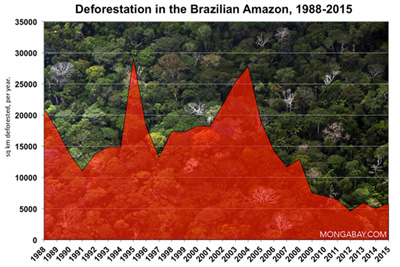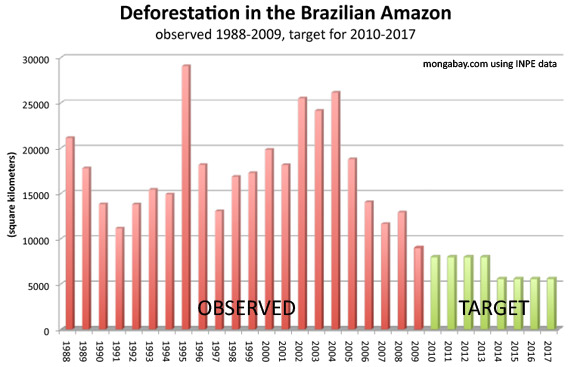Deforestation in the Brazilian Amazon fell nearly 46 percent to the lowest annual loss on record in 2009, reported the Brazilian government Thursday.
INPE, the country’s space agency, found that 7,008 square kilometers (2,705 square miles) of forest were cleared during the 12-month period ended July 2009, the lowest extent since annual record-keeping began in 1988.
“The new deforestation data represents an extraordinary and significant reduction for Brazil,” President Luiz Inacio Lula da Silva said in a statement.

|
The Brazilian government attributed most of the reduction to increased enforcement effort, including fines, arrests, and seizure of cattle and crops produced on illegally deforested lands, but analysts suggest that falling commodity prices have had a more significant impact in the trend. Agricultural production is an increasingly important driver of forest clearing and conversion in the Amazon.
The reduction in Amazon deforestation comes a year after Brazil announced an ambitious plan to reduce forest loss by 70 percent by 2018 as part of its climate policy. Deforestation accounts for more than three-fifths of Brazil’s greenhouse gas emissions and nearly 20 percent of emissions worldwide. Brazil is seeking billions of dollars from industrialized nations for its efforts to reduce deforestation.

Related
Brazil’s plan to save the Amazon rainforest

(06/02/2009) Accounting for roughly half of tropical deforestation between 2000 and 2005, Brazil is the most important supply-side player when it comes to developing a climate framework that includes reducing emissions from deforestation and forest degradation (REDD). But Brazil’s position on REDD contrasts with proposals put forth by other tropical forest countries, including the Coalition for Rainforest Nations, a negotiating block of 15 countries. Instead of advocating a market-based approach to REDD, where credits generated from forest conservation would be traded between countries, Brazil is calling for a giant fund financed with donations from industrialized nations. Contributors would not be eligible for carbon credits that could be used to meet emission reduction obligations under a binding climate treaty.
How to save the Amazon rainforest
(01/04/2009) Environmentalists have long voiced concern over the vanishing Amazon rainforest, but they haven’t been particularly effective at slowing forest loss. In fact, despite the hundreds of millions of dollars in donor funds that have flowed into the region since 2000 and the establishment of more than 100 million hectares of protected areas since 2002, average annual deforestation rates have increased since the 1990s, peaking at 73,785 square kilometers (28,488 square miles) of forest loss between 2002 and 2004. With land prices fast appreciating, cattle ranching and industrial soy farms expanding, and billions of dollars’ worth of new infrastructure projects in the works, development pressure on the Amazon is expected to accelerate. Given these trends, it is apparent that conservation efforts alone will not determine the fate of the Amazon or other rainforests. Some argue that market measures, which value forests for the ecosystem services they provide as well as reward developers for environmental performance, will be the key to saving the Amazon from large-scale destruction. In the end it may be the very markets currently driving deforestation that save forests.







